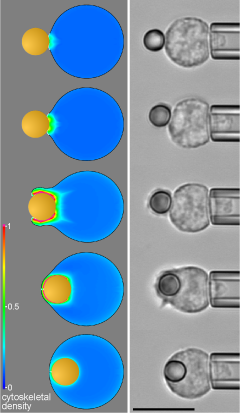Jump to: Single-Cell Approach || Target-Specific Phagocytosis || Phagocyte-Specific Phagocytosis || Recent Publications
SINGLE-CELL APPROACH
  White blood cells form the frontline defense of our immune system against pathogenic invaders. Neutrophils, macrophages, and monocytes are capable of neutralizing foreign objects by phagocytosis. This vital process depends on two complementary parts: the timely recognition of pathogens, and the immune cells’ aptitude to change their shape and do mechanical work. Much effort has been devoted to mapping the signaling networks involved in the detection, uptake, and processing of phagocytic targets. However, little is known about the fundamental mechanisms orchestrating the interplay between immune recognition and controlled cellular motion.We have pioneered an interdisciplinary approach to study the mechanistic underpinnings of one-on-one interactions between immune cells and various targets that mimic pathogens. It is based on dual-micropipette manipulation of individual cells and targets. Typical experiments are illustrated in the movies below (sped up ~25 times): White blood cells form the frontline defense of our immune system against pathogenic invaders. Neutrophils, macrophages, and monocytes are capable of neutralizing foreign objects by phagocytosis. This vital process depends on two complementary parts: the timely recognition of pathogens, and the immune cells’ aptitude to change their shape and do mechanical work. Much effort has been devoted to mapping the signaling networks involved in the detection, uptake, and processing of phagocytic targets. However, little is known about the fundamental mechanisms orchestrating the interplay between immune recognition and controlled cellular motion.We have pioneered an interdisciplinary approach to study the mechanistic underpinnings of one-on-one interactions between immune cells and various targets that mimic pathogens. It is based on dual-micropipette manipulation of individual cells and targets. Typical experiments are illustrated in the movies below (sped up ~25 times):
|
||||||||||
| Advantages of this approach [Lee et al. 2011]: | ||
|
TARGET-SPECIFIC PHAGOCYTOSIS MECHANICS
The above single-cell approach has allowed us to discover, quantify, and explain intriguing differences between two prominent immunological pathways: the response to fungal targets (mimicked using zymosan particles), and antibody-mediated phagocytosis [Lee et al. 2011; Herant et al. 2011].

|
Movies below are sped up ~25-30 times. | 
|
|||
 |
 |
||||
 |
 |
||||
Neutrophil phagocytosis of a zymosan particle (left) and an antibody-coated bead (right).Top row: experiments. [Lee et al. 2011]Bottom row: computer simulations. [Herant et al. 2011][Click thumbnails to play in separate windows.] |
|||||
PHAGOCYTE-SPECIFIC MECHANICS OF PHAGOCYTOSIS
[…]
RECENT PUBLICATIONS ON PHAGOCYTOSIS
2013. Mankovich, A.R., C.-Y. Lee, and V. Heinrich. Differential effects of serum heat treatment on chemotaxis and phagocytosis by human neutrophils. PLoS ONE 8(1): e54735. doi:10.1371/journal.pone.0054735 || PDF 907 KB
2011. Heinrich, V., and C.-Y. Lee. Blurred line between chemotactic chase and phagocytic consumption: An immunophysical, single-cell perspective. Journal of Cell Science 124(18):3041-3051. doi:10.1242/jcs.086413 || low-res. PDF 702 KB
2011. Lee, C.-Y., M. Herant, and V. Heinrich. Target-specific mechanics of phagocytosis: Protrusive neutrophil response to zymosan differs from the uptake of antibody-tagged pathogens. Journal of Cell Science 124(7):1106-1114. doi:10.1242/jcs.02876 || PDF 1104 KB
2011. Herant, M., C.-Y. Lee, M. Dembo, and V. Heinrich. Protrusive push versus enveloping embrace: Computational model of phagocytosis predicts key regulatory role of cytoskeletal membrane anchors. PLoS Computational Biology 7(1): e1001068. doi:10.1371/journal.pcbi.1001068 || PDF 274 KB
2009. Lam, J., M. Herant, M. Dembo, and V. Heinrich. Baseline mechanical characterization of J774 macrophages. Biophysical Journal 96:248-254. doi:10.1529/biophysj.108.139154 || PDF 768 KB
2006. Herant, M., V. Heinrich, and M. Dembo. Mechanics of neutrophil phagocytosis: experiments and quantitative models. Journal of Cell Science 119:1903-1913. doi:10.1242/jcs.02876 || PDF 727 KB
2005. Herant, M., V. Heinrich, and M. Dembo. Mechanics of neutrophil phagocytosis: behavior of the cortical tension. Journal of Cell Science 118(9):1789-1797. doi:10.1242/jcs.02275 || PDF 731 KB






